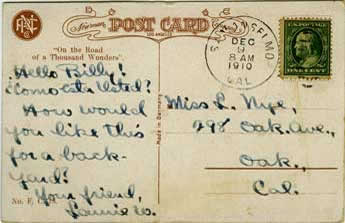Divided Back Postcards
1907–1915
Once again bowing to public demand, Congress finally passed a law granting permission for postcard backs to have both mailing addresses and personal messages, following recent postal innovations that had already been adopted in Europe. With the backs of postcards now divided into two sections—one for the address, the other for a message, separated by a thin rule or a line of small type—senders could now include a much longer message in the allotted space. Since the front of a postcard no longer needed any kind of margin or white space for short messages, images were expanded to fill the entire frame.


The picture postcard frenzy exploded. Billions were published around the globe. The divided back era is known as the “Golden Age of Postcards” for the sheer quantity of cards published, purchased and mailed.
Germany was the world leader in picture postcard printing technology and quality, and its artists and print shops were known for vivid colors, excellent artwork, fine details and superior lithographic processes. Some of the most prolific postcard artists moved to Germany, where many postcards of American scenes were printed.
This author finds that postal cards produced up until 1915 can be especially beautiful and exquisite. Like fine, miniature landscape (or seascape) paintings; color lithographs of urban scenes; or even photographers’ images of festivals or events, picture postcards of this era are often gorgeous, charming and imbued with rich history. Cards actually mailed contain the added bonuses of attractive postage stamps, interesting postmarks, and mundane or fascinating messages, sometimes written by pen and ink in decorative, stylish scripts, or even in foreign languages.
